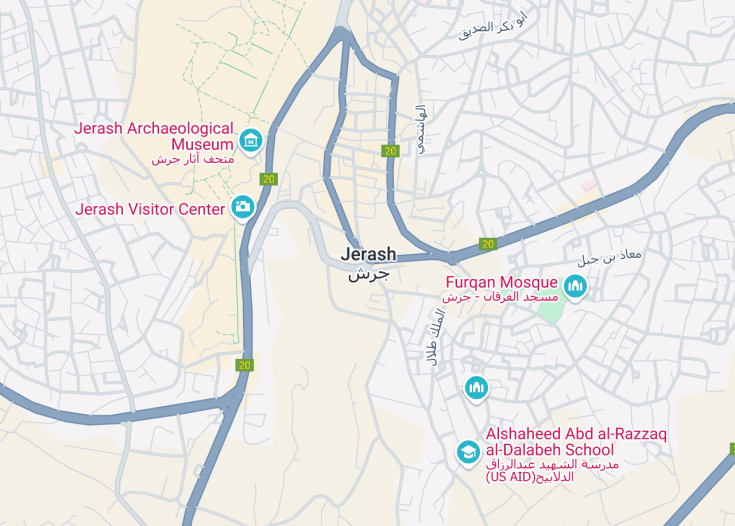Nestled in the heart of the Jordan Valley, Jerash stands as one of the best-preserved Greco-Roman cities in the Middle East. This ancient city, often referred to as the “Pompeii of the East,” offers a fascinating peek into the grandeur of a bygone era with its colonnaded streets, vast temples, and imposing theaters.
Visitors can explore an array of ruins that beautifully illustrate the architectural genius of ancient civilizations. The annual Jerash Festival transforms the city into a bustling hub of cultural and artistic expression, making it a must-visit destination for history enthusiasts and cultural aficionados alike.
Ensure to visit during early morning or late afternoon to avoid the heat and enjoy the archaeological sites in more comfortable temperatures.
Wearing comfortable walking shoes is advisable as the site involves a considerable amount of walking on uneven surfaces.
Top things to do & see in Jerash
Select the following sights and activities to discover best tickets and tours available in Jerash.
Jerash: A Glimpse into Ancient Civilizations
| Country | Jordan |
| Time in Jerash | GMT+3 |
| Language spoken | Arabic |
| Population | 31,650 (According to the 2015 Census – Jordan Department of Statistics) |
| Currency | Jordanian Dinar (JOD, د.ا) |
| Airports |
|
Jerash, located in Jordan, is a treasure trove of ancient history, often referred to as the Pompeii of the East due to its well-preserved Greco-Roman ruins. Its historical significance as one of the largest and most well-preserved sites of Roman architecture outside Italy makes it a key attraction.
Jerash’s ancient city, known as Gerasa in antiquity, highlights an unbroken chain of human occupation dating back more than 6,500 years, showcasing various civilizations that have influenced the Mediterranean world.
Where is Jerash?
Jerash is nestled in the hills of Gilead in Jordan, offering scenic landscapes and a rich historical backdrop.
Distances:
| Route | Distance by car | Time by car |
|---|---|---|
| From Amman to Jerash | 30 miles (48 km) | 1 hour |
| From Irbid to Jerash | 40 miles (64 km) | 1 hour 10 minutes |
| From Zarqa to Jerash | 35 miles (56 km) | 50 minutes |
What is Jerash famous for?
Jerash is renowned for its grand ruins of the Greco-Roman period, including the well-preserved colonnaded streets, temples, theaters, and plazas which attract scholars, tourists, and historians alike.
History
Ancient Times: Before 331 BC
Jerash, known in antiquity as Gerasa, has been inhabited since the Neolithic Age, evidenced by archaeological finds indicating human occupation from around 7500 BC. This early settlement grew significantly under the influence of the successive Bronze and Iron Ages.
Hellenistic Period: 331 BC – 63 BC
After Alexander the Great’s conquests, the region came under Hellenistic control, with Jerash as a key urban center. This period marked the beginning of substantial architectural developments, including the introduction of typical Hellenic urban structures and the construction of the Hippodrome.
Roman Rule: 63 BC – 4th Century AD
Jerash reached its zenith during Roman governance, becoming one of the Decapolis cities – a group of ten cities on the eastern frontier of the Roman Empire in the Levant. The city was adorned with colonnaded streets, grand temples, and theaters, majorly as a result of the Pax Romana which facilitated architectural and cultural advancements.
Byzantine Period: 4th Century – 7th Century
Christianity became the dominant religion, and Jerash saw the construction of several churches, some beautifully decorated with mosaics. During this time, the city’s architecture integrated Christian symbols and structures.
Early Muslim Period: 7th Century – 11th Century
The Umayyad and subsequent Abbasid caliphates oversaw Jerash. However, several earthquakes coupled with changing trade routes led to a gradual decline in its urban significance.
Modern Era: 19th Century – Present
The rediscovery of Jerash occurred in the 1800s by Western explorers. Modern excavations began earnestly in the 1920s, revealing its extensive ruins which have since become a focal point for archaeological studies and tourism, pivotal in Jordan’s cultural heritage preservation.
Visit Jerash
What to see and do in Jerash, Jordan.
Visiting Jerash offers a glimpse into its glorious past. Explore the ancient city’s ruins that include the Oval Plaza, an impressive set of 56 Ionic columns, and the Cardo, a colonnaded street that was once the city’s commercial hub.
The Jerash Archaeological Museum offers fascinating insights with its collection of artifacts from the site.
- Take a guided tour to understand the historical context of the ruins.
- Witness the Jerash Festival of Culture and Arts for live performances in a historical setting.
Annual Cultural Extravaganza.
Jerash is renowned for the Jerash Festival of Culture and Arts, typically held during July and August. This event transforms the ancient ruins into vibrant stages for musical and dance performances, showcasing both local and international artists.
Best time to visit Jerash
The optimal time to visit Jerash is during spring (March to May) or autumn (September to November). These months offer pleasant weather, ideal for exploring the extensive outdoor ruins comfortably.
Is Jerash worth visiting?
Jerash is unquestionably worth a visit. As one of the best-preserved Roman provincial towns in the world, it offers a rare chance to walk through history. The ruins are magnificent and incredibly comprehensive, providing a tangible connection to the ancient civilizations that once thrived here.
Visiting Jerash not only offers cultural and historical insights but also a unique journey into the past that is both educational and awe-inspiring.










